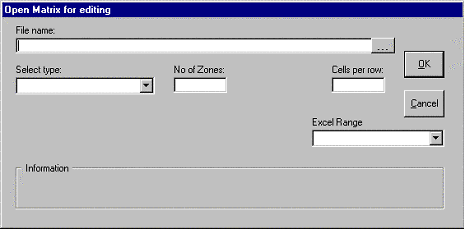
The Furness procedure is used to make a trip matrix represent a future year. It does this by growthing-up the matrix to a set of forecast year trip ends. This forecast year trip matrix can be assigned to a network in the normal way so as to forecast the traffic on the network. To produce the forecast year trip matrix the software requires as input the file name of the base year trip matrix, the file name of the forecast year trip ends and the file name which is to hold the forecast year trip matrix.
The trip ends of a matrix comprise the row totals (which represent the number of trips which originate from a zone), and the column totals (which represent the number of trips destined for a zone). The number of trips originating from each zone and destined for each zone can be calculated for a future year (e.g. from the National trip end model) and applied to the base year trip matrix to produce a forecast year trip matrix.
The algorithm the software uses to produce the forecast year trip matrix starts by applying the growth to each origin of the base year trip matrix so as to match the forecast row totals. However this then gives a new matrix, which has new column totals that do not in general match the forecast column totals. The software then applies the growth to each column of the matrix in turn so as to match the forecast column totals. This then produces new row totals, which in general do not match the forecast ones. The process is iterated so that each successive iteration updates the base year trip matrix by factoring up each row and column in turn until both the rows and columns match the forecast row and column totals. Convergence is achieved when the row and columns change by only a few trips between each iteration which in practice is usually within about five or six iterations. If certain conditions are met (e.g. that there are no negative cells) then the theory shows that the procedure converges on a unique solution.
There are two major issues with the Furness procedure. The first is that if the base year matrix has zero trips coming from a zone or destined for a zone then no traffic can be forecast for that zone. This typically occurs where a zone has no development in it in the base year but which is developed in the future year. The second is where the base year matrix contains certain cells which are zero but which would have some trips in them. This can occur if the matrix is constructed from roadside (or on board public transport) interviews in which case certain cells of the matrix could have a zero estimated number of trips when in fact they could contain trips - it is just that the survey did not detect any. The common way round this is to seed the matrix with a small value so as to give the Furness something to growth-up on.
Another problem with this is that the destination of the new trips is unrelated to the distance between the origin and destination zone when there is strong empirical evidence to show that the number of trips between origin and destination drops off as the distance between them increases. In addition when the transport links between a zone pair are improved then the evidence shows that some trips are diverted from one destination to the now more attractive destination using the improved transport link. Changes in the transport network should therefore be reflected in the distribution model.
An alternative distribution model, which incorporates this factor, is the Gravity Model.
Running the Furness
Pd-Edit provides the capability for Furnessing matrices. Samples of the files required to undertake a Furnessing procedure have been supplied with the pd-Edit test data.
Click Models/Distribution to display a sub menu that has three Furnessing options at the top.
Furnessing from the grid
Furness O-D Cell Text File
Furness Binary Erica Matrix
Each of these will now be discussed in turn.
Furnessing from the grid.
In order to undertake this procedure you firstly need to open the base year trip matrix. This matrix is called Jbo.dat and is stored in the test data stored in the directory \test data\pdEdit\Furnessing.
On the Matrices menu click File/Open to display the form below.

Click  and
browse to the Furnessing test data, select the Jbo.dat file and Click
Open.
and
browse to the Furnessing test data, select the Jbo.dat file and Click
Open.
Jbo.dat is an O-D Cell matrix type. Click the drop down list and select o-d cell.
There are 20 zones in this matrix so enter 20 in the Number of Zones text box.
The form should now look like this: -
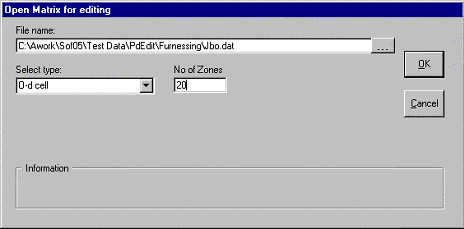
Click OK to open the matrix (below)
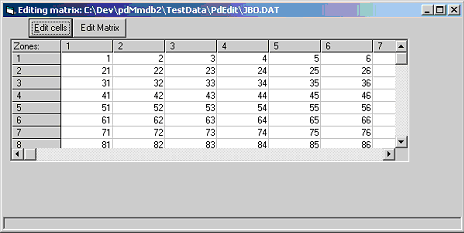
On the Models menu click Distribution/Furness from the Grid. The form below appears.
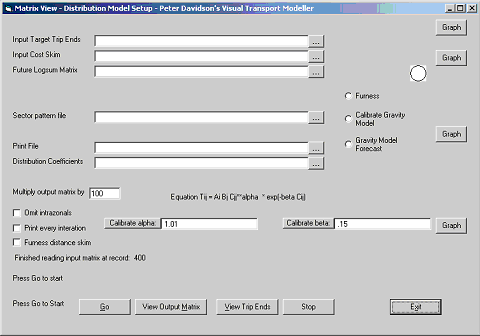
Click the Furness option to hide text boxes
that are not required for Furnessing. The
input target trip ends file is called Teinput.txt stored in the same location
as Jbo.dat. Click
 to browse, select the file and click Open.
to browse, select the file and click Open.
The Print File can be given any name providing the extension is .txt. The software will create the file in the location chosen. Alternatively there is a file called MxOutput.txt in the same location as Jbo.dat, which can be used for this purpose.
The next text box enables the user to factor the output matrix file by a set parameter. Use this feature to capture decimal places in your output. If you leave this value at 100 it will multiply all values in the output file by 100. For our purposes change this value to 1.
The form should now look like this: -
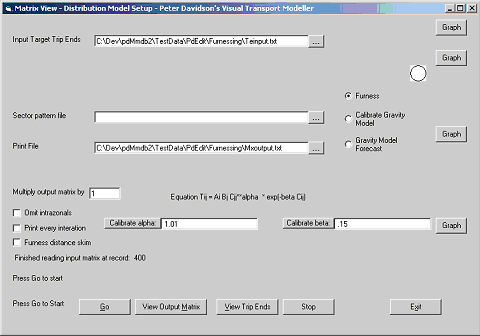
Click Go to run the Furness.
Once completed Click View Output Matrix to view the Furnessed Matrix (below)
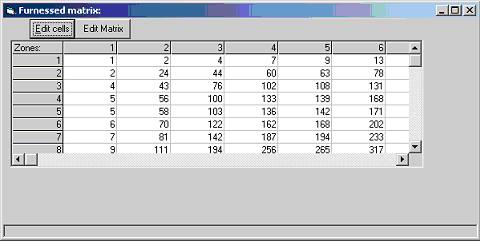
This matrix can now be saved from the Matrix menu by clicking File/Save As. Remember to use a new file name so as not to overwrite your existing files.
Furnessing an O-D Cell Text File.
Click Models/Distribution and then choose the Furness O-D Cell Text File option. The form below appears
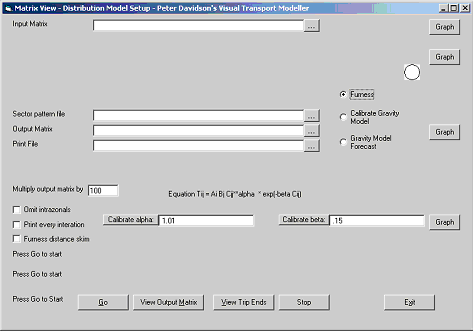
The input matrix is called Jbo.txt stored
with the pd-Edit test data in Test Data\pdEdit\Furnessing. Click  to browse select the file and Click Open.
to browse select the file and Click Open.
The input target trip ends file is called
Teinput.txt stored in the same location as Jbo.txt. Click
 to browse, select the file and click Open.
to browse, select the file and click Open.
You can select an Output matrix and Print file name as long as they have a .txt file extension. These files will be created by the system.
The form should now look like this: -
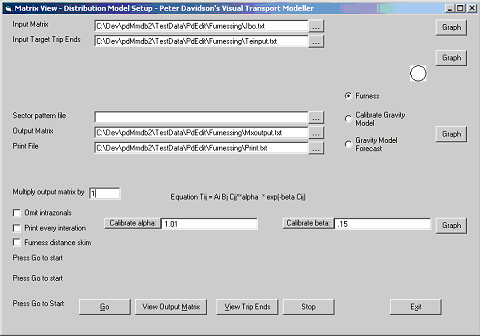
Click Go to run the Furness.
Once the Furness has been completed you need to close the form and open the output matrix in pd-Edit to view the results of the Furness procedure.
Furnessing a Binary Erica Matrix
The process for this is exactly the same as for an O-D Cell Text File except the input and output matrices are in Binary Erica – Trip format with a file extension of .bmt.
The Print File
The Print File stores the calculations and iterations of the Furnessing procedure. You can choose whether to view all the iterations or just the final one by checking the Print Every Iteration button on the Furnessing a Matrix form.